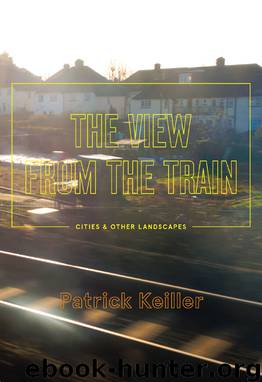The View From the Train by Patrick Keiller

Author:Patrick Keiller
Language: eng
Format: epub
Publisher: Verso Books
Published: 2013-11-04T16:00:00+00:00
The Swiss Chalet
Vivienne Lower, senior custodian of the Dickens Centre, showed us the Chalet. She ascended the external stair, followed by Cedric, and unlocked the door to the upper room, which was a little difficult to open, the weather having been very wet. The building’s exterior is, or at least appears, very recently painted, practically as new, but the interior is beautifully aged in surface and odour, and surprisingly dry. The smell was that of sun-warmed, tongue-and-groove pine interiors not often opened to the outside air – summer houses, boat sheds and so on. The furniture more or less matches, but is not original. I photographed the stand-in for Dickens’s waste-paper basket, and made some attempts at portraiture.
The room is about four metres square and, I guessed, perhaps three high. We discussed the mirrors. Cedric asserted the superiority, at least in this context, of virtual space over actual space, but I was trying to frame a picture without appearing in it in a mirror, and missed the rest of this. He had recently addressed a conference on virtual reality, in Berlin. We agreed that Dickens would have enjoyed the juxtaposition of actual views through the windows and virtual views in the mirrors, perhaps more than being merely surrounded by windows.
There is an essay by Eisenstein setting out the similarities between Dickens’s narratives and the forms of early Soviet cinema. Eisenstein, it seems, regarded Dickens as the pioneer of montage.8 I had never followed up this aspect of Dickens, who was, with a number of other English-language writers (such as Oscar Wilde and Laurence Sterne) sometimes misunderstood in England, big in (revolutionary) Russia. While I knew of Sterne’s influence on the Russian Formalists, I had never previously read The Pickwick Papers but, having discovered Cedric’s enthusiasm for it, by the day of our journey had reached Chapter 8. Like Sterne’s Tristram Shandy, it is much influenced by Cervantes’s Don Quixote, and in Chapter 50 of Pickwick, Dickens has Sam Weller allude to Sterne’s Sentimental Journey.
I had not realised how close Pickwick is to the eighteenth century, both in its date and in the innovative structures of its narrative. It was Dickens’s first novel, set in 1827 and written and published, as a commissioned serial, in 1836–37, when he was only twenty-four. It was, on the other hand, the product of a nineteenth-century technological revolution, that of mass-produced, cheap paper, and was a runaway commercial success – so much so that, within the period of its serialisation, Pickwick soaps and Weller corduroys were on sale, and portraits of ‘Boz’ appeared on London omnibuses.
Cedric, on the other hand, had not read much Sterne, and we were retracing Pickwick’s exploration of a period which, while pre-Victorian, is long past the beginning of the nineteenth century. The slightly later period, when Dickens was writing, is that of Marc Brunel’s Thames Tunnel (his son Isambard narrowly survived an accident working on this in 1827); the first railways (Euston Station opened in 1836); mains gas for cooking
Download
This site does not store any files on its server. We only index and link to content provided by other sites. Please contact the content providers to delete copyright contents if any and email us, we'll remove relevant links or contents immediately.
Shoot Sexy by Ryan Armbrust(17637)
Portrait Mastery in Black & White: Learn the Signature Style of a Legendary Photographer by Tim Kelly(16933)
Adobe Camera Raw For Digital Photographers Only by Rob Sheppard(16881)
Photographically Speaking: A Deeper Look at Creating Stronger Images (Eva Spring's Library) by David duChemin(16599)
Bombshells: Glamour Girls of a Lifetime by Sullivan Steve(13952)
Art Nude Photography Explained: How to Photograph and Understand Great Art Nude Images by Simon Walden(12954)
Perfect Rhythm by Jae(5305)
Pillow Thoughts by Courtney Peppernell(4188)
The Book of Joy by Dalai Lama(3882)
Good by S. Walden(3468)
The Pixar Touch by David A. Price(3344)
A Dictionary of Sociology by Unknown(2998)
Fantastic Beasts: The Crimes of Grindelwald by J. K. Rowling(2975)
Humans of New York by Brandon Stanton(2814)
Stacked Decks by The Rotenberg Collection(2796)
Read This If You Want to Take Great Photographs by Carroll Henry(2653)
On Photography by Susan Sontag(2562)
Insomniac City by Bill Hayes(2478)
Photographic Guide to the Birds of Indonesia by Strange Morten;(2476)
